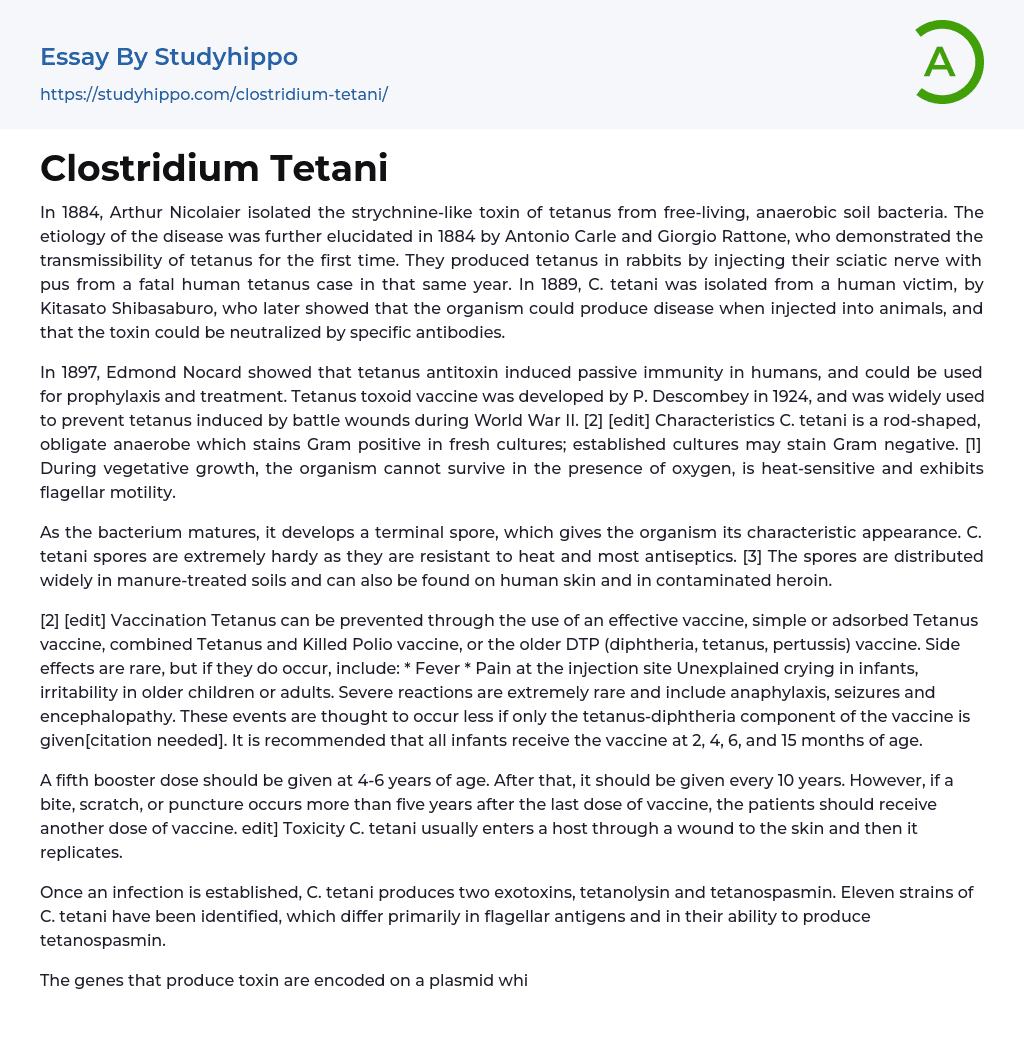In 1884, the tetanus toxin was discovered in soil bacteria by Arthur Nicolaier. The disease's transmission was demonstrated the same year by Antonio Carle and Giorgio Rattone, who induced it in rabbits using pus from a human tetanus case. In 1889, Kitasato Shibasaburo isolated C. tetani from a human victim and proved its ability to cause illness in animals while demonstrating that specific antibodies could neutralize the toxin. Edmond Nocard showed in 1897 that tetanus antitoxin could produce passive immunity in humans. During World War II, P. Descombey created the Tetanus toxoid vaccine to prevent tetanus caused by battle wounds.
C. tetani is an obligate anaerobe with rod-shaped morphology that stains Gram positive but may stain Gram negative when established cultures are present; during vegetative growth, it develops flagellar motility but cannot survive with oxygen due t
...o heat sensitivity. As it matures, it creates spores at the terminal end that are resistant to heat and most disinfectants; these spores can be found on manure-treated soil as well as human skin and contaminated heroin.
To prevent Tetanus through vaccination, one can use simple or adsorbed vaccines such as Tetanus vaccine combined with Killed Polio vaccine or older DTP vaccines;side effects of which include rare fever occurrences alongside pain at injection sites for infants accompanied by unexplained crying while irritability occurs among older children and adults.Severe reactions like anaphylaxis, seizures, and encephalopathy are very uncommon.It is recommended that all infants receive the vaccine at 2, 4, 6, and 15 months of age. Additionally, a booster dose should be given at 4-6 years of age and every 10 years thereafter. If more than five years have passed since the last
dosage and a wound occurs, another dose should be administered. C. tetani gains entry through skin wounds and produces two exotoxins known as tetanolysin and tetanospasmin. There are eleven strains of C.tetani which differ mainly in flagellar antigens but share genes that produce identical toxins on a plasmid; however, tetanolysin doesn't benefit C.etani. The neurotoxin known as tetanospasmin results in clinical symptoms associated with tetanus and is produced by living bacteria during spore germination or vegetative growth; minimal amounts of both spore germination and vegetative cell growth are required for toxin production to occur. Among toxins, Tetanospasmin has one of the lowest human lethal doses with approximately175 nanograms being lethal for humans weighing about70 kg (154 lbs) or having a minimum lethal human dose of about 2.5 nanograms per kilogram body weight.Although Botulinum toxin produced by Clostridium botulinum and the exotoxin created by Corynebacterium diphtheriae, which causes diphtheria, have similar structures to Tetanospasmin, they are more hazardous to humans. However, Tetanospasmin is different from Botulinum toxin since it relies on zinc metalloproteinase for its function. C. tetani produces a single 150kDa polypeptide progenitor toxin known as Tetanospasmin that can be cleaved into fragment A (a 50kDa "light chain") and fragment B (a 100 kDa "heavy chain") via a protease or trypsin-induced fragmentation through a disulfide bridge connection. After being transported to the central nervous system via nerve axons from the host's blood and lymphatic system, Tetanospasmin attaches to gangliosides at presynaptic junctions of inhibitory motor nerve endings affecting various sites within the central nervous and sympathetic nervous systems. Clinical symptoms involve unopposed muscle contraction and spasm, risus sardonicus, trismus, opisthotonus seizures along with autonomic nervous
system effects when inhibitory impulses are blocked.To prevent tetanus infection; an initial vaccine regimen comprising shots given at 2,4 ,6 months of age recommended with booster before entering school followed by every ten years afterward for lifelong immunity must be administered since C.tetani infection cannot provide complete protection against it.It is crucial to administer tetanus vaccination after stabilizing the patient upon diagnosing tetanus infection. This disease is not contagious but only infectious, making it the only vaccine-preventable disease that falls into this category.
- Pregnancy essays
- Death essays
- Asthma essays
- Chronic Pain essays
- Diabetes essays
- Infection essays
- Infertility essays
- Pain essays
- Sexually Transmitted Disease essays
- Cholesterol essays
- Epidemic essays
- Pathogen essays
- Symptom essays
- Water supply essays
- Myocardial Infarction essays
- Chronic essays
- Hypertension essays
- Black Death essays
- Breast Cancer essays
- Down Syndrome essays
- Apoptosis essays
- Tuskegee Syphilis Experiment essays
- Type 2 Diabetes essays
- Cloning essays
- Medical Ethics essays
- Patient essays
- Therapy essays
- drugs essays
- Cannabis essays
- Aspirin essays
- Cardiology essays
- Hemoglobin essays
- Pharmacology essays
- Surgery essays
- alternative medicine essays
- Plastic Surgery essays
- Organ Donation essays
- Vaccines essays
- Medical essays
- Dentist essays
- Psychological Trauma essays
- Physical therapy essays
- Cold essays
- Cocaine essays
- Why Marijuana Should Be Legalized essays
- Drug Abuse essays
- Teenage Drug Abuse essays
- Heart Disease essays
- Artery essays
- Addiction essays




